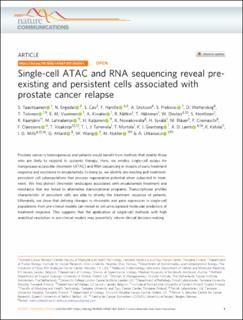Single-cell ATAC and RNA sequencing reveal pre-existing and persistent cells associated with prostate cancer relapse
Taavitsainen, S.; Engedal, Nikolai; Cao, S.; Handle, Florian; Erickson, A.; Prekovic, Stefan; Wetterskog, D.; Tolonen, Teemu T.; Vuorinen, E.M.; Kiviaho, A.; Nätkin, R.; Häkkinen, T.; Devlies, W.; Henttinen, S.; Kaarijärvi, R.; Lahnalampi, M.; Kaljunen, H.; Nowakowska, K.; Syvälä, H.; Bläuer, M.; Cremaschi, P.; Claessens, Frank; Visakorpi, Tapio; Tammela, T.L.J.; Murtola, T.; Granberg, K.J.; Lamb, Alastair D.; Ketola, Kirsi; Mills, Ian; Attard, Gerhardt; Wang, W.; Nykter, Matti; Urbanucci, Alfonso
Journal article, Peer reviewed
Published version

Åpne
Permanent lenke
https://hdl.handle.net/11250/2990799Utgivelsesdato
2021Metadata
Vis full innførselSamlinger
- Department of Clinical Medicine [2066]
- Registrations from Cristin [9791]
Sammendrag
Prostate cancer is heterogeneous and patients would benefit from methods that stratify those who are likely to respond to systemic therapy. Here, we employ single-cell assays for transposase-accessible chromatin (ATAC) and RNA sequencing in models of early treatment response and resistance to enzalutamide. In doing so, we identify pre-existing and treatment-persistent cell subpopulations that possess regenerative potential when subjected to treatment. We find distinct chromatin landscapes associated with enzalutamide treatment and resistance that are linked to alternative transcriptional programs. Transcriptional profiles characteristic of persistent cells are able to stratify the treatment response of patients. Ultimately, we show that defining changes in chromatin and gene expression in single-cell populations from pre-clinical models can reveal as yet unrecognized molecular predictors of treatment response. This suggests that the application of single-cell methods with high analytical resolution in pre-clinical models may powerfully inform clinical decision-making.
